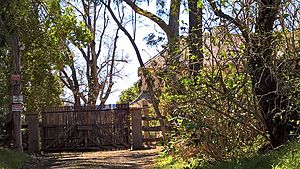Clear Oaks facts for kids
Quick facts for kids Clear Oaks |
|
|---|---|

Clear Oaks 135 Francis Street, Richmond, New South Wales
|
|
| Location | 135 Francis Street, Richmond, City of Hawkesbury, New South Wales, Australia |
| Built | 1819 |
| Official name: Clear Oaks Moxey's Farm House; Moxey's Farm | |
| Type | state heritage (complex / group) |
| Designated | 2 April 1999 |
| Reference no. | 58 |
| Type | Homestead Complex |
| Category | Farming and Grazing |
| Lua error in Module:Location_map at line 420: attempt to index field 'wikibase' (a nil value). | |
Clear Oaks is a very old and special house in Richmond, Australia. It's a homestead complex, which means it includes the main house and the land around it. This historic place was built around 1819. It is also known as Moxey's Farm House. Clear Oaks is listed on the New South Wales State Heritage Register because it's an important part of history.
Contents
The Story of Clear Oaks
The First People of the Land
Long, long ago, the land where Clear Oaks stands was home to the Dharug people. They lived near the Nepean River and South Creek. These rivers were very important for finding food. The Dharug and Darkinjung people called the river Deerubbin. It was a vital source of food and a way to travel.
European Settlers Arrive
In 1789, Governor Arthur Phillip explored this area. He was looking for good land for farming. He found and named the Hawkesbury River after Baron Hawkesbury. This region became very important for the early European settlement in Australia.
By 1794, European settlers had made their homes here. The area was first called Green Hills. It had very fertile land, which was great for farming. This helped the new colony survive during difficult times. However, the Hawkesbury River often flooded, which could ruin the farmers' crops and homes.
Building Clear Oaks
Clear Oaks is built on land that was given to a free settler named David Langley in 1804. This land grant was for 100 acres. Experts believe that Clear Oaks was built for David Langley. It's also thought that a person named James Vincent helped build the house.
There was already a building on the land when Langley sold it in 1819. A man named Joseph Onus bought the property. It's likely that Onus made improvements to the building. He probably added a plaster-like coating called "bagging" to the bricks.
What Clear Oaks Looks Like
Clear Oaks is a two-story farmhouse made of brick. It has a special coating called stucco, which makes it look smooth. The house has a wide verandah around the ground floor. This verandah is supported by wooden posts. The roof is gabled, meaning it has a triangular shape at the ends.
The windows have nine small panes of glass. The outside doors are unusual, with six panes of glass. Most of the original wooden parts, like the doors and window frames, are still there. The way the house is placed on the land is also very important. The heritage listing includes the land around the house, all the way to the roads and the bottom of the hill behind it.
Why Clear Oaks is Special
Clear Oaks is a great example of a Colonial Georgian farmhouse. This style of house was common in the Hawkesbury valley a long time ago. It also looks very nice as you approach the town. The house stands out at the end of Bosworth Street.
Clear Oaks, also known as Moxey's Farm House, was officially listed on the New South Wales State Heritage Register on April 2, 1999. This means it is protected because of its historical importance.

